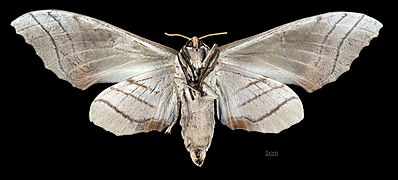Marumba sperchius
| Marumba sperchius | |
|---|---|

| |
| Scientific classification | |
| Domain: | Eukaryota |
| Kingdom: | Animalia |
| Phylum: | Arthropoda |
| Class: | Insecta |
| Order: | Lepidoptera |
| Family: | Sphingidae |
| Genus: | Marumba |
| Species: | M. sperchius
|
| Binomial name | |
| Marumba sperchius | |
| Synonyms | |
| |
Marumba sperchius is a species of moth of the family Sphingidae first described by Édouard Ménétries in 1857.
Distribution
It is found from north-western and north-eastern India, south-western, central and eastern China to the southern Russian Far East, North Korea, South Korea and Japan.[2] It is also present on Sumatra and Borneo.
Description
The wingspan is 88–138 mm. It is similar to Marumba juvencus, but the lines of the forewing and the ground colour of the hindwing are more reddish and the lines on either side of the weak discal spot are hardly converge.
-
Female, dorsal view
-
Female, ventral view
-
Male, dorsal view
-
Male, ventral view
Biology
There are two generations per year with adults on wing in April and again in August in northern China. In Korea, adults are on wing from late May to late August.
The larvae have been recorded feeding on Castanea (including C. crenata), Castanopsis, Quercus (including Q. glauca, Q. mongolica, Q. acutissima, Q. myrsinaefolia, Q. acuta, Q. salicina and Q. serrata), Castanea crenata, Juglans (including J. regia and J. mandschurica), Lithocarpus (including L. edulis) and Eriobotrya species. Early instars are pale yellow, while later instars turn bluish green with the tubercles brown or reddish, tipped with white. Oblique stripes are formed of mauve or yellow tubercles on a white ground. The horn is green with paler tubercles.[3]
Subspecies
- Marumba sperchius sperchius (from north-western India across north-eastern India, south-western, central and eastern China to the southern Russian Far East, North Korea, South Korea and Japan)
- Marumba sperchius sumatranus Clark, 1923 (Sumatra, Borneo)
-
Female M. s. sumatranus, dorsal view
-
Female M. s. sumatranus, ventral view
-
Male M. s. sumatranus, dorsal view
-
Male M. s. sumatranus, ventral view
References
- ^ "CATE Creating a Taxonomic eScience - Sphingidae". Cate-sphingidae.org. Archived from the original on 2012-12-09. Retrieved 2011-11-01.
- ^ Pittaway, A. R.; Kitching, I. J. (2018). "Marumba sperchius sperchius (Ménétriés, 1857) -- Large swirled hawkmoth". Sphingidae of the Eastern Palaearctic. Retrieved December 16, 2018.
- ^ Holloway, Jeremy Daniel. "Marumba sperchius Menetries". The Moths of Borneo. Retrieved January 11, 2019.








